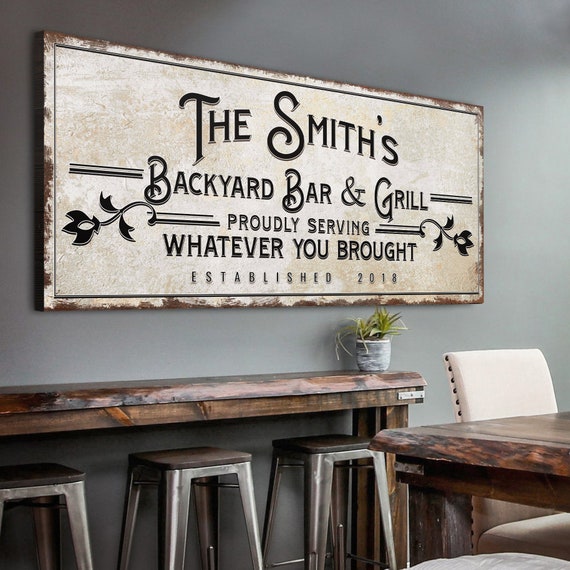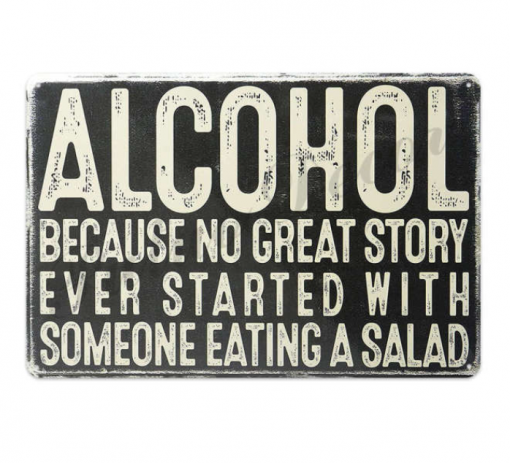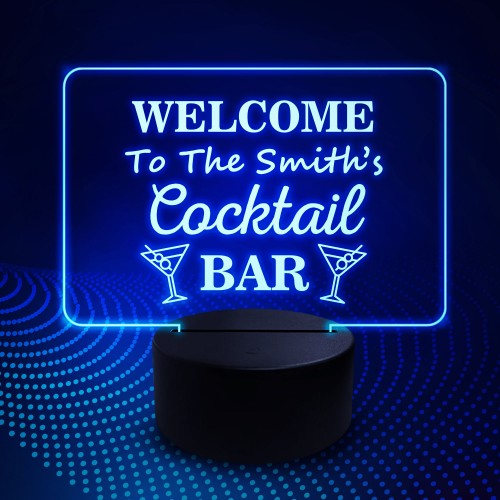Good News On Picking Bar Runners
Wiki Article
How Are Bar Signs Designed And Styled Differently?
Bar signs vary in style and design to suit the ambience, theme and intended audience of the bar. Here are the main style and design variations: 1. Vintage/Retro
The characteristics of this style are classic, vintage style, usually weathered or shabby.
Vintage logos, old-fashioned images, wood or metal with aged finishes are all design elements.
Uses: Perfect for bars that feature an old-fashioned theme, such as speakeasies and pubs. Also traditional American diners.
2. Modern
Characteristics: Sleek, clean, minimalist.
Design Elements: Fonts using simple or bold fonts, in monochromatic geometric shapes, constructed from acrylic or metal or other materials.
Uses: Perfect for stylish cocktails bars, modern bars, and elegant lounges.
3. Rustic
Characteristics: Natural and earthy.
Design elements Utilization of reclaimed wood hand-painted or carved letters natural colors, as well as rustic finishes.
Applications: This product is suitable for bars with rural vibe and restaurants serving farm-to-table table meals, as well as mountain lodges.
4. Industrial
Characteristics: Raw, unfinished, edgy.
Design Elements: Exposed Metal pipes, reclaimed materials as well as neutral tones and bold fonts.
Applications: Ideal for bars in converted warehouses lofts, urban environments.
5. Glamorous
Characteristics: Elegant, luxurious, eye-catching.
Design Elements: The use of silver, gold and other metallics, glitter ornamental fonts, ornate fonts, as well as sophisticated graphics.
Applications: Perfect for high-end bars and nightclubs with customers who are high-end.
6. Nautical
Characteristics include a coastal, marine and adventurous theme.
Design Elements: Anchors and ships as nautical symbols, blue and white color schemes and rope and wooden textures.
Uses: Ideal beach bars, waterfront restaurants, and seafood establishments.
7. Tropical
Characteristics: Bright, colorful, relaxed.
Design Elements Design Elements: Bright colors, bright tropical plants and palm trees. Fonts that are playful. Images of beaches.
Uses: Great for tiki bars, beach clubs, and other establishments with a theme of islands.
8. Sports
Characteristics: Energetic, team-oriented, spirited.
Design elements Design Elements: Team logos, sports images, bold colors and vibrant fonts.
Uses: Great for sports bars, pubs, and fan zones that cater to sports enthusiasts.
9. Steampunk
Characteristics: Futuristic, Victorian, mechanical.
Design elements: Cogs, gears, pipes, brass, and old fonts, leather textures.
Uses: Perfect to create themed bars that combine the best of both worlds.
10. Art Deco
Characteristics: Glamorous, geometric, bold.
Design elements: Geometric designs, gold and black color schemes as well as elegant fonts.
Uses: Great for bars seeking elegance in the 1920s Gatsby.
11. Humorous/Quirky
Characteristics: Fun, light-hearted, engaging.
Design elements: Fun fonts that have humorous slogans. Cartoonish graphics.
It is a great option for casual bars, dive-bars, and other venues where you want to create fun and relaxed ambience.
12. Traditional Pub
Characteristics: Warm, inviting, classic.
Dark wood, classic typefaces heraldic icons, and classic pub imagery.
Uses : Perfect for British, Irish and European pubs.
13. Western
Characteristics: Rustic, rugged, cowboy-themed.
Design Elements The Cowboy image rope fonts, rope and wood texture.
The bars are suitable for those with a theme of Western, BBQ places, and Country Music venues.
14. Neon
The characteristics are bright colors, vivid and eye-catching.
Design elements: Neon lighting with a variety of colors, usually with simple and striking graphics and fonts.
Uses: Great for bars and nightclubs which are seeking to provide a an energetic, fun vibe.
15. Minimalist
Characteristics: Simple, clean, understated.
Design Elements: Simple graphic and text Monochromatic or limited shades of color, elegant fonts.
Uses: Perfect for bars that are modern and upscale seeking an elegant and chic look.
Bar owners can improve the experience for their patrons by selecting the best design and design. It will also enhance the atmosphere and theme. See the top rated right here on home pub signs for site recommendations including the staying inn pub sign, to the pub sign, bar signs for home bar, personalised hanging bar sign, pub signs personalised, hanging home bar signs, outdoor personalised bar sign, personalised signs for home bar, novelty bar signs, modern pub sign and more.

What Are The Differences Between Bar Signs, In Terms Of Installation And Mounting?
The kind of bar sign, its size, its weight, their place of installation, and their use will determine how it's mounted and put up. Here is a look at how to install and mount bar signs. Wall-Mounted Signs
Attaching the wall directly.
Methods:
Screws and Anchors are utilized to secure heavier signs (metal or wood).
Adhesive Tape: Can be used on lighter signs like foam board or acrylic.
Brackets used to support signs hanging off the walls to provide greater visibility.
Uses: Indoor decor, menu boards, directional signs.
Benefits: Multi-functional, secure, and allows for prominent display.
Negatives: May damage walls, difficult to move.
2. Hanging Signs
Characteristics Suspended overhangs or ceilings.
Methods:
Chains: durable and adjustable ideal for large signs.
Cables: A slimmer look. Most often used in modern designs.
Rods: Provide a rigid support structure.
Uses: Ceiling decor, directional signs, overhead promotional signs.
Vertical space is very visible and the decorative options are limitless.
Disadvantages
3. Freestanding Signs
Characteristics: Not tied to any other structure, supported by a base or stand.
Methods:
A-Frames are portable and foldable frequently used to promote sidewalk advertisements.
Pedestal Stands: Stable base, ideal for indoor use.
Post and Panel: Used for larger permanent signs.
Uses: Outdoor advertising, indoor directional signs, promotional displays.
The portable and flexible design makes it easy to alter.
It is often bulky and requires floor space.
4. Window Signs
The characteristics of the windows are directly attached to them.
Methods:
Suction cups are easy to install, remove and suitable for lighter signs.
Adhesive Glass: Can be applied directly to the surface of the glass. It is ideal for graphics, decals as well as other graphics.
Static cling is reusable, non-permanent adhesive that is easy to take off or apply.
Uses: Promoting message, branding and operating hours.
Benefits: The most windows and highly visible from outside.
Window size limitations and sunlight can affect the performance.
5. Backlit and Edge Lit Signs
Characteristics: Incorporate lighting within the structure of the sign.
Methods:
Wall Mounting with Electrical Connections It requires a secure attachment and electrical hookups.
Suspended with Power Cables: Combines hanging method with integrated lighting.
Uses: Branding with high visibility, menu boards and decorative elements.
Benefits: Increase visibility, attractive illumination.
Installation is more complicated and requires electricity.
6. Temporary and portable Signs
Specifications Designed to facilitate simple and quick set-up.
Methods:
Pop-Up stand: light and compact.
Banner Stands: Roll-up or retractable designs.
It is used for events, promotions and seasonal decorations.
Quick and easy setup.
Advantages: Not as durable, may not be as stable.
7. Magnetic Signs
Magnetic force is used to attach.
Methods:
Magnetic Strips: Adhered to the back of the sign.
Magnetic Boards: Signs are attached to a metallic surface.
Uses: Menu boards with a changeable layout, temporary notices.
Advantages Easy to change. There are no permanent fixtures to be used.
Limitations: Only available on surfaces with magnetic properties, not as secure.
8. Projection Signs
Specifications Lights are used to project images or texts.
Methods:
Mounted Projectors: Securely mounted to ceilings or walls.
Portable Projectors : Positioned either on stands or on other surfaces.
Displays that are dynamic include as well as events and promotions.
Advantages: No requirement to buy the physical sign, since the content can be easily changed.
Disadvantages: Requires an environment that is controlled for lighting and is dependent on the projector's quality.
Considerations for mounting and installation
Size and Weight
Heavy Signs: These signposts require more robust solutions for mounting, including anchors and screws.
Light Signs are made with a variety of methods including suction cups and adhesive strips.
Durability
Permanent Signs: Choose more secure and long-lasting mounting methods.
Temporary signs: Pick methods that are simple to take down and move.
Location
Indoor: Greater flexibility of techniques and materials with less concern about weather resistance.
Outdoor: Weather-resistant material is required, as well as a sturdy mounting system that will protect against the elements.
Aesthetics
Concealed mounts give an elegant appearance by hiding the hardware.
Signs can be enhanced with decorative hardware.
Accessibility
Easy Access to Changes For signs that are changed regularly, such as menu boards.
Security: Signs are secured from being easily altered and stolen.
By considering these factors the bar owners can select the best mounting and placement techniques that meet their specific needs, ensuring the security of their signage visible and accordance with their bar's design and functional needs. Have a look at the recommended bar sign outdoor for site advice including modern pub sign, to the pub sign, personalised cocktail bar sign, the staying inn sign, bar signs, pub signs for garden, pub bar signs for sale, to the bar sign, personalised metal pub signs, personalised pub signs and more.

What Is The Distinction Between Bar Signs That Are Interactive As Opposed To Other Signs For Bars?
There are various levels of interactivity that can be used on bar signs to enhance customer interaction and experience. Below is how bar signs differ in terms of interactivity:1. Static Signs
Traditional Design: Signs that are static convey information without any interactive elements.
Common forms include printed posters, painted murals or typical neon signs.
2. Digital Displays
Digital Signs: These signs can be updated in real-time with animated content and multimedia.
Touchscreen displays are interactive and can show games, promotional materials, menus or any other type of content.
Benefits: Draw attention to the latest information, while promoting patron engagement.
3. QR Codes
Interactive Links QR codes that are displayed on signs could lead to menus, social media profiles, and also promotions.
Benefits of the app Access to more information and promotions.
4. LED Screens
LED screens display animated text, videos as well as animations.
LCDs with touch-enabled touchscreens permit viewers to interact with their contents. This includes selecting menu options, or playing games.
Benefits: Create experiences that are immersive, grab attention and effectively communicate information.
5. Projection Mapping
Immersive Experiences: Projection mapping transforms surfaces into dynamic displays that provide interactive visuals and story telling.
Interactivity: Patrons are able to interact with interactive elements like games or virtual experiences.
Benefits: Make memorable experiences, improve ambience, and increase social interaction.
6. Augmented Reality (AR).
AR is a type of enhanced reality, which overlays digital information on the real world to allow for interactive experiences.
The AR-enabled signage gives patrons the possibility of engaging with virtual components. For example they can look up cocktails recipes, and play virtual games.
Benefits: Reward patrons by engaging them and offer unique experiences to make your bar stand out.
7. Motion Sensors
Motion sensors are used to detect movement in signage and trigger interactive responses.
Interactivity Signs respond to patron's movements by showing animations or changing the contents. They also can send personalized messages.
Benefits You can create immersive environments that make your guests feel special and delighted.
8. Social Media Integration
Online Interaction: Signs may contain hashtags or handles for social media to encourage people to interact on the internet.
Users-generated Content: Encourage patrons to post photos of the signage on social media platforms expanding the reach and visibility of a bar.
Benefits: Increase awareness of brands and encourage community involvement.
9. Interactive Lighting
Dynamic Effects Neon or LED Signs that have Interactive Lighting can Respond to the sound of a touch or motion.
Signs can be interactive by changing brightness, color or patterns based on the interaction between patrons or other environmental signals.
Benefits: Create a sense of immersion which enhance ambiance, as well as captivate interest.
10. Gamification
Interactive Games: Signs with interactive games and challenges that entertain customers and encourage participation.
You may offer discounts or incentives for completing challenges or games.
Benefits : Increase time spent. Foster social interaction. Promote repeat visits.
Bar owners who include interactive elements in their signage will be able to create an interactive experiences that draw the attention of patrons, boost brand recognition, as well as differentiate them from the rest of a competitive market. Follow the recommended bar sign advice for website recommendations including bar sign outdoor, make a pub sign, the pub sign, bar signs, pub signs for garden, garden bar sign personalised, garden bar signs, bar sign hanging, large personalised bar signs, home garden bar signs and more.
